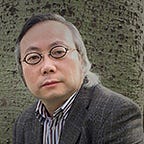文/王 林
艺术创作始终是个人的事儿。一个人生活在这个信息纷纭、资讯繁复的世界上,最要面对的便是多元文化的交流、碰撞、冲突和融合。美国学者塞缪尔·亨廷顿抽出其冲突方面,视之为世界分裂的依据。然而,冲突固然不可避免,政治家也念念不忘利用它来为自己的政治目的服务。但所谓文化,说到底也就是人在不同环境和不同历史中的生存方式。所以,相信人类有共同属性的人们总会努力,去做世界文化在碰撞中的交流和在冲突中的融合。因为对个人而言,文化的丰富性 — — 古今往来,东西南北 — — 既是精神充实的基础,亦是个性独特的前提。傅文俊有志于此,善莫大焉。
傅文俊在世界各地穿行,用镜头收集为之感动的图像,从建筑到街景,从人像到艺术品。他从不依靠瞬间抓拍来完成作品。从一开始,就通过拍摄来为后期绘制作准备。为此,他更多关注那些实体感强的对象,以弥补电脑图像的虚拟性。他把以前对东西文化对比的兴趣,转移到世界文化的古今变化上。这种调整使傅文俊在很大程度上得以摆脱意识形态制约,重返艺术天性与文化感悟的创造性过程。近作中异乎寻常的偶发与任意,显然体现出他离距操控性力量的自由与自信。
首先,他已不在乎摄影和绘画的区别,其画面往往通过对摄影图像的破坏而成形。这不独是因为遗存的残缺本身就承载着历史沧桑,更是因为在不同文化的相互关系中,某种文化的完整性并不存在。要求这种完整性往往是出于文化霸权的要求。从某种意义上讲,亨廷顿正是秉持西方文化中心论,才会得出文化必然冲突、世界必然分裂的结论。原文化主义和原教旨主义一样,在今天已无胜利之可能。传统文化的零散化、片段化,与当代文化的开放性、包容性和相互嵌入的可能性是相辅相成的。当我们在傅文俊作品中,看到相距万里、相隔千年的不同文化如此协调地并置一处时,你可以感到,今天的人们确已生活在新的文化心理之中。 对傅文俊而言,各种文化的交集是自然而然的,他要面对的无非是眼前这台将一切图像汇聚其中的电脑视屏。摄影素材进入其中,早已离开来源现场,成为激发灵感的资讯。他之所为乃是如何去感受历史和今天、对象和个人的关系。因为有破坏的自由与重组的可能,傅文俊既不在乎摄影的纪实性,亦不在乎绘画的风格化。随手涂鸦的线条、任意隐显的形体、突如其来的光暗以及基调单纯或冷暖复杂的色彩,再加上摄影后期处理的各种手段,使傅文俊眼前画面极具变化性:叠加与透明、高清与朦胧、实体与空灵、大笔横扫与颗粒变化等等。傅文俊真正进入到电脑快捷处理、临场自由发挥的创作状态。这种创作状态是发生学和过程性的,其个人特点的形成既非理思亦非规约,而是主观构想与潜能激发相互作用、相互推动的结果。我们从画面上斑驳、绚丽、丰富甚至繁复到极致的色彩效果,可以感受到傅文俊创作时的兴奋,其中充满激越的艺术天分与冲动的美学追求。
傅文俊作品的后期制作占了很大比重,但不同于电脑绘画的是,他始终不弃摄影形象,在虚幻图绘中仍然留恋摄影与真实的联系。他的摄影是不断被绘制涂改的摄影;他的绘画是手工性无法完成的绘画。正是在真与幻、实与虚的无穷变化中,艺术或能捕捉到历史与人、人与历史的秘密。
有感于傅文俊作为一个摄影艺术家与众不同的创作面貌,我称其近作为“数绘摄影”。
关于作者王林:中国艺术批评家,四川美术学院教授,西安美术学院博士生导师。
Culture Integration and Digital Pictorial Photography
— — Review on Fu Wenjun’s recent artworks
By Wang Lin
Art creation is always a personal matter. We live in a world with diverse and complicated information, so it’s crucial to be able to face the multi-cultural communication, collision, conflict and integration. The American scholar Samuel P. Huntington draws out the aspect of conflict, and believes it as the proof of world split. However, the conflict is inevitable, and the politicians never forget to make use of it to serve their political purposes. But the so-called culture, to the end, is the way of living under different circumstances and different historical moments. Therefore, people who believe in common human natures will always strive for the world cultures’ communication among the collisions and for the integration among the conflicts. In personal terms, the diversity of culture — — from ancient to modern times, in every corner of the world — — is the base of spiritual abundance as well as the precondition for personality. It is noteworthy that Fu Wenjun aspires to it.
Fu Wenjun travels around the world and collects the images that inspire him, from architecture to street scenes, from portraits to artworks. He doesn’t rely on image shot straight away to complete his works. Just from the beginning, while shooting, he’s getting prepared for the later stage of “painting”. He is more interested in the solid subjects, in order to make up the virtuality of the digital images. His attention moves from the comparison of the Western and the Eastern culture into the changes of the world cultures from the ancient times to now. This makes Fu Wenjun be able to get rid of the restriction of ideology, going back to the creative process inspired by the artistic nature and the perception on cultures. In his recent works, the extraordinary accidental and arbitrary elements obviously show his freedom and confidence on separating himself from the power of control.
Firstly, he doesn’t care about the difference between photography and painting. His works come into being by the destruction of the photographic images. This is not only because the incomplete remains carry the vicissitudes of history, but also because, within the mutual relationship of different cultures, the integrity of a certain culture doesn’t exist. The demand of this integrity starts always from the cultural hegemony. In a sense, Huntington believes in Western culture-centered theory, so that he draws the conclusion: cultures are bound to conflict, world is bound to split. Cultural and religious fundamentalism can’t succeed in our times. The traditional culture is scattered and fragmentary, the contemporary culture is open, tolerant and integrative, meanwhile both are inseparably interconnected. In the works of Fu Wenjun, you can find that the different cultures with a very long distance and time can be juxtaposed harmoniously, so you can feel that nowadays people really live with a new cultural psychology. To Fu Wenjun, diverse cultural integration is a very natural thing; what he should face is just the computer screen that gathers all images. Photographic source materials have left their original situation, go into the computer and become the information that will stimulate the artist’s inspiration. What he is doing is to feel the relationship between history and present time, the objects and the individuals. Because Fu Wenjun has the freedom of destruction and the possibility of recombination, he doesn’t care about the documentary nature of the photography, neither the style of painting. Thanks to scrawl lines, freely-appearing or hidden forms, unexpected light and darkness, simple or cool-warm combined colors, and various photo post-treatment methods, his artwork images are very variable: juxtaposition and transparency, high definition and obscurity, solid and dreamlike effects, harsh brushstrokes and slight changes. Fu Wenjun has really entered a computer quick processing and freely on-the-spot creative state, which is phylogenic and stepwise. The formation of his personal style is not rational nor based on the regulations, but is the result of the interaction and the mutual promotion between the subjective conception and the potentiality stimulation. From the mottled, bright, abundant and even extremely complicated color effects, we can feel Fu Wenjun’s excitement during the art creation, filled with intense art endowments and impulsive aesthetic pursuits.
In Fu Wenjun’s works, post-production is an important part, but different from computer painting, he never gives up with the images shot and throughout the illusory image drawing he always loves the relation between photography and reality. His photography is the result of a continuous drawing and altering process; his “painting” is a “painting” which can’t be finished by hand. Just along with the endless changes of reality and illusion, fact and fiction, the art probably can catch the secrets within history and human beings, human beings and history.
Inspired by Fu Wenjun’s distinctive creation as a photography artist, I call his recent works “digital pictorial photography”.
About the author Wang Lin: Chinese art critic, Professor at Sichuan Fine Arts Institute, Doctorial Supervisor at Xi’an Academy of Fine Arts.
